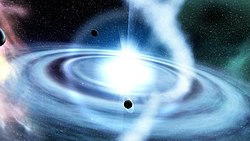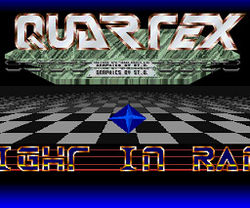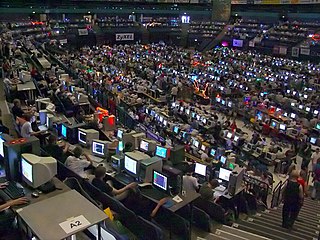| Demoscene |
|---|
 |
| Concepts |
| Alternative demo platforms |
| Current parties |
| Websites |
| Magazines |
| Software |
Hugi is one of the longest-running [1] and most frequently released demoscene and underground [2] [3] disk magazines (diskmag) for IBM-PC.
| Demoscene |
|---|
 |
| Concepts |
| Alternative demo platforms |
| Current parties |
| Websites |
| Magazines |
| Software |
Hugi is one of the longest-running [1] and most frequently released demoscene and underground [2] [3] disk magazines (diskmag) for IBM-PC.
The first issues were in German language and were released in 1996. From issue 11 on the magazine issued in German and English. With issue 18 the German part became a separate magazine called Hugi.GER. Moreover, in the years 1998 to 2000 there was a weekly newsletter which continued the tradition of similar publications such as Demonews.
Hugi developed from a kind of electronic school magazine to one of the most successful [4] and long-living demoscene and underground magazines. The contents are mainly based on contributions from the readers and only proofread and formatted by the editors. Topics include graphics, demos, demoparties, programming, other diskmags, reports, politics and literature. Each issue also features graphics and background music.
Articles from Hugi have been cited in all three doctoral theses about the demoscene that have been published in the years 2011 to 2017. [5] [6] [7] The book Hacking Europe - From Computer Cultures to Demoscenes, from 2014, also mentions Hugi in one chapter. [8]
38 issues were released until June 2014, 17 of which were partially or completely in German. 12 issues were also translated to the Russian language. Moreover, five issues of the German language offspring Hugi.GER, 38 newsletters and 4 special editions (Coding Digest, Hugibox music disk, Interview Bonanza and Special Edition #4) were released. The main editor of Hugi, Claus D. Volko (Vienna, Austria), is also known as “Adok” in the demoscene.
Hugi was one of the first diskmags that was released as a Windows executable (September 1998). Moreover, it was a dual DOS and Windows diskmag for 6 issues (September 1998 to August 1999). Both facts were strongly notable at this time and caused a lot of discussion. [ citation needed ] The magazine uses the engine "Panorama", which was created for Hugi by the Polish programmer Chris Dragan. Many other electronic magazines are nowadays also based on it.
| Issue | Release month | Text amount | Code by | Graphics by | Music by | Remarks |
|---|---|---|---|---|---|---|
| HDE #1 | May 1996 | 420 kB | Adok | Adok | - | Music in the early issues was taken from freeware MOD collections |
| HDE #2 | August 1996 | 460 kB | Adok | Adok | - | |
| HDE #3 | November 1996 | 340 kB | Adok | Kaktus | - | |
| HDE #4 | January 1997 | 450 kB | Adok | Kaktus | - | |
| Hugi #5 | March 1997 | 430 kB | Adok | Adok | - | New text viewer with smooth scrolling in text mode |
| Hugi #6 | May 1997 | 680 kB | Adok | Adok | - | Completely new engine in SVGA |
| Hugi #7 | August 1997 | 530 kB | Adok | Dr. Brain, Adok | - | |
| Hugi #8 | October 1997 | 620 kB | Adok | Dr. Brain, Adok | - | |
| Hugi #9 | December 1997 | 880 kB | Adok | Mr. SEQ | Mr. SEQ | Again a new engine, with various new features; includes an English corner |
| Hugi #10 | April 1998 | 850 kB | Adok | Mr. SEQ | Mr. SEQ | Last regular issue with mostly German articles |
| Hugi #11 | June 1998 | 1.0 MB | Adok, Salami | Antony, Hellfire, Dendrite | Smash | First issue with mostly English articles |
| Hugi #12 | September 1998 | 1.8 MB | Street Raider | Will Be, Hellfire, Mr. SEQ | Makke | New engine, now for both DOS and Windows |
| Hugi #13 | November 1998 | 1.2 MB | Street Raider | Cereal | MasterBoy, CoaXCable, Steffo | |
| Hugi #14 | February 1999 | 1.4 MB | Street Raider | Hellfire, Luminos | BenJam, Laxical, Makke | |
| Hugi #15 | May 1999 | 1.4 MB | Street Raider | Hellfire, Scape | Nightbeat, Dawnstar | |
| Hugi #16 | July 1999 | 2.1 MB | Street Raider | FloOd, TAD | Bacter, Echo | |
| Hugi #17 | August 1999 | 1.4 MB | Street Raider | Raven of Defacto 2, Hellfire | Avalanche, P-rat, Spin | |
| Hugi #18 | December 1999 | 0.9 MB | Chris Dragan | Dines | Acumen, Andromeda, Traymuss, Ciccilleju, Kenedy | New engine with many new features, more professional looks than before |
| Hugi #19 | April 2000 | 1.3 MB | Chris Dragan | Bridgeclaw, TAD | Makke, P-rat, JKL | |
| Hugi #20 | August 2000 | 864 kB | Chris Dragan | CoaXCable, Mali, TAD | Ciccilleju, Stanley | |
| Hugi #21 | December 2000 | 867 kB | Chris Dragan | Kthulu, Mali, TAD | Yero, Acumen, Exodus | |
| Hugi #22 | April 2001 | 852 kB | Chris Dragan | Kthulu, nldsr | Iliks, Chavez, JKL, Smirk, Rieha, Ciccilleju | Features mostly chiptunes as background music |
| Hugi #23 | August 2001 | 1.3 MB | Chris Dragan | Partikle, nldsr | Steffo, Gopher, CoaXCable | Contains a Bachelor thesis about the demoscene |
| Hugi #24 | January 2002 | 880 kB | Chris Dragan | Critikill, Fjrb, Tomaes | JosSs, Daike, Substance, Peal Hunter, Iliks | |
| Hugi #25 | July 2002 | 967 kB | Chris Dragan | Fusko, Fjrb, TAD | Iliks, Bozo, Zalza, Look | |
| Hugi #26 | February 2003 | 1023 kB | Chris Dragan | Raven of Nuance, LoneStar, Fjrb, TAD | Gargoyle, JDruid, JosSs, Qumran, Chavez, Arel Frost, Iliks, Zalza | Contains a special corner about Winamp skinning |
| Hugi #27 | July 2003 | 630 kB | Chris Dragan | Seven 11, TAD, Steve Bian | My Voice, Gloom, Merlin, Teller | |
| Hugi #28 | December 2003 | 630 kB | Chris Dragan | Raven, TAD, Sunchild | Eterman, Luke, Impulse | |
| Hugi #29 | August 2004 | 520 kB | Chris Dragan | Raven, LoneStar, Adok | Melcom, Dynamite, Valzihjken, Kenedy, CoaXCable | |
| Hugi #30 | February 2005 | 906 kB | Chris Dragan | LoneStar | JDruid, SpiiKKi, Converse, LoneStar, JosSs, Stanley | |
| Hugi #31 | November 2005 | 620 kB | Chris Dragan | Bridgeclaw, nldsr, LoneStar | rzs, Stanley, Pearl Hunter, Anarkimedes | |
| Hugi #32 | August 2006 | 930 kB | Chris Dragan | Critikill, Mantraz, Bridgeclaw | Slashy, Dafunk, Lex, Lesnik, Nightbeat, Rieha, Aquafresh | 10-year-anniversary issue; first issue with a higher resolution (1024x768) |
| Hugi #33 | April 2007 | 800 kB | Chris Dragan | Bridgeclaw, Noogman | Siatek, Buzzer, Mice, Chromag | First issue to use music in MP3 format |
| Hugi #34 | February 2008 | 1080 kB | Chris Dragan | Tascha, Bridgeclaw | Chromag, Traymuss, Siatek | |
| Hugi #35 | November 2008 | 780 kB | Chris Dragan | Fabian, Ra | Jogeir Liljedahl, Siatek, Buzzer, Mice, Traymuss | |
| Hugi #36 | April 2010 | 900 kB | Chris Dragan | Alena Lazareva, Anthony Gargasz, Dzordan, Fabian, Ra, Bridgeclaw, Rork | Moby, Romeo Knight, Siatek, Traymuss, pOWL, Magnar | Contains the full "International Diskmag Encyclopedia" |
| Hugi #37 | April 2012 | 850 kB | Chris Dragan | Bridgeclaw, Dzordan, Forcer, Rork, Fabian | Magnar, Traymuss, Romeo Knight, CONS, Chaser, Chromag, Siatek | |
| Hugi #38 | June 2014 | 1.1 MB | Chris Dragan | Forcer, Slayer, Prince | Magnar, Wiklund, Mantronix, Traymuss, Hoffman, Chaser, Siatek, Xerxes, Revisq |
Hugi has attracted a large amount of controversy itself roughly after its 26th issue; many sceners complained that a large portion of articles were uninteresting and not related to the demoscene itself. This problem was further emphasized by the fact that Hugi editors were accused by spamming demoscene forums by requests for articles, even though a considerable portion of the scene had denounced Hugi by this time. [9] [10] Interest has been since rekindled for the latest issues, as the editor crew has announced to apply more intense quality control over their articles.
The 30th issue of Hugi was a subject of confusion when it appeared that the 'demoscene' section of the magazine could only be accessed through a self-confessed 'IQ-test'. The test was viewed by most demoscener readers as gratuitous and not serving any practical purpose, especially because it was relatively easily bypassable with e.g. trial and error. [11]
The 35th issue of Hugi raised a yet unseen backlash, when it was discovered that the mag contained an article opposing immigration to Europe from Islamic and African countries because of the immigrants' religion and their allegedly low IQ. [12] While the article was removed within 6 hours, questions were raised whether the article slipped through quality control (the scenario supported by the editors, but considered preposterous by the readers), was included because of simply of the yellow journalistic value, or whether main editor Adok simply included the article because he agreed with the content, after he initially did not apologize or comment on the issue. [13] The article was later revealed by the author to be a complete ruse, a copy-paste from Wikipedia and a text written by Finnish philologist Mikko Ellilä, aimed to test whether the article of such content could get in the final magazine. [14] The diskmag was near-universally condemned, [15] amid additional accusations of "jumping the bandwagon" started by diskmag ZINE of having a "headlines" demo to increase anticipation, copying ZINE's unique 3-by-2 thumbnailed layout and "roundtable" interviews.
The 36th issue of Hugi, from April 2010, garnered mostly positive feedback.
The Hugi staff also hosts a popular series of online Assembler programming and size-optimizing contests called “Hugi Size Coding Competition”. The objective is to implement a given program using as little space as possible. This results in executable files with a size of far less than one kilobyte. Since 1998, 29 competitions have been held so far. The number of participants per contest is usually 20 - 80. Participants come from virtually all over the world (North America, Europe, East Asia, South Africa, Australia,...). Every contestant gets points depending on the size of their entry. After each competition, the entries are released together with source code, and a discussion in a mailing list occurs in which objections regarding the validity of the entries can be made. The authors of invalid entries receive a penalty. Once a year, a "world league table" is generated in which the points from all contests held in that year have been added together.

Amiga demos are demos created for the Amiga home computer.

A crack intro, also known as a cracktro, loader, or just intro, is a small introduction sequence added to cracked software. It aims to inform the user which "cracking crew" or individual cracker removed the software's copy protection and distributed the crack.

Demogroups are teams of demosceners, who make computer based audio-visual works of art known as demos. Demogroups form a subculture collectively known as the demoscene.

The demoscene is an international computer art subculture focused on producing demos: self-contained, sometimes extremely small, computer programs that produce audiovisual presentations. The purpose of a demo is to show off programming, visual art, and musical skills. Demos and other demoscene productions are shared, voted on and released online at festivals known as demoparties.

Future Crew was a Finnish demogroup that created PC demos and software, active mostly between 1987 and 1994.

The Assembly demoparty is an annual demoscene and gaming event in Finland. It is the biggest and the longest standing demoscene party. The Summer event takes place every year at Messukeskus in Helsinki, between late July and early August, and lasts three to four days. The 2020 edition was held online.
Farbrausch, or Farb-rausch, is a German group of demomakers who became well known in the demoscene in December 2000 with a 64k intro called "fr-08: .the .product". The demo achieved its small size through the use of procedural textures, a custom MIDI-based software synthesizer V2, and a modified version of UPX executable compressor, ".the .product" is an 11-minute 3-D show featuring complex scenes of computer generated imagery.
tAAt is a Finnish humor-based demogroup founded in 1992 which is active in participating and organizing demoscene events. They are recognized outside of the demoscene for their Dismount series of computer games, including Stair Dismount (Porrasturvat), Truck Dismount (Rekkaturvat) and Dismount Levels.

Breakpoint was an annual demoscene party held in Bingen, Germany during Easter from 2003 to 2010. The successor to Mekka & Symposium, an annual German demoscene party that had ended in 2002, Breakpoint grew to become the largest annual event focused solely on the demoscene. It attained over 1000 visitors at its height, attracting demosceners from Germany, Sweden, Finland, Poland, Spain, Australia, and Canada, among others. It was also the host of the Scene.org Awards ceremony from 2003 to 2010.
Christian Wirth, better known by the pseudonym RaD Man, is an American computer artist and historian. He works in the field of ANSI art, a method of creating art using a limited set of text characters and color escape codes based loosely on the relevant ANSI standard.

Second Reality is an IBM PC compatible demo created by the Finnish demogroup Future Crew. It debuted at the Assembly 1993 demoparty on July 30, 1993, where it was entered into the PC demo competition, and finished in first place with its demonstration of 2D and 3D computer graphics rendering. The demo was released to the public in October 1993. It is considered to be one of the best demos created during the early 1990s on the PC; in 1999 Slashdot voted it one of the "Top 10 Hacks of All Time". Its source code was released in a GitHub repository as public domain software using the Unlicense on the 20th anniversary of the release on 1 August 2013.
Tristar and Red Sector Incorporated (TRSI) is a demogroup which formed in 1990. It came about from the longest-running cooperation in scene history. RSI existed from 1985, before being joined by the "T" later on. Evolving from the Commodore 64 to the Amiga and later to PC and various game console platforms - like the PlayStation, Xbox, Nintendo - and set-ups like Arduino, Android or Blu-ray, TRSI released a number of digital productions, dedicated to experimenting in phreaking or network alteration. Its members were spread around the world and still contribute to computer scene art and code after more than 27 years of history.

A disk magazine, colloquially known as a diskmag or diskzine, is a magazine that is distributed in electronic form to be read using computers. These had some popularity in the 1980s and 1990s as periodicals distributed on floppy disk, hence their name. The rise of the Internet in the late 1990s caused them to be superseded almost entirely by online publications, which are sometimes still called "diskmags" despite the lack of physical disks.
Triton (TRN) was a demogroup active in the PC demoscene from 1992 to about 1996.
The Judges was a Dutch Commodore 64 group from Roosendaal known for being one of the earliest dedicated demogroups. The Judges released several demos for the Commodore 64 home computer between the years 1986 - 1988. Groups such as The Judges are regarded as early pioneers of what came to be known as the demoscene.

Razor 1911 (RZR) is a warez and demogroup founded in Norway, 1985. It was the first ever such group to be initially founded exclusively as a demogroup, before moving into warez in 1987. According to the US Justice Department, Razor 1911 is the oldest software cracking group that is still active on the internet. Razor 1911 ran the diskmag 'Propaganda' until 1995.
Phenomena (PHA) was a Swedish Demogroup making Amiga demos that was productive during the formative years of the Amiga Demoscene founded in 1987.
The Exceptions were a German demo group formed in the 1980s. They were early pioneers writing demos for the Atari ST platform.

Scene World Magazine is a disk magazine for the Commodore 64 home computer. The magazine has been released regularly since February 2001.
{{cite web}}: CS1 maint: archived copy as title (link)